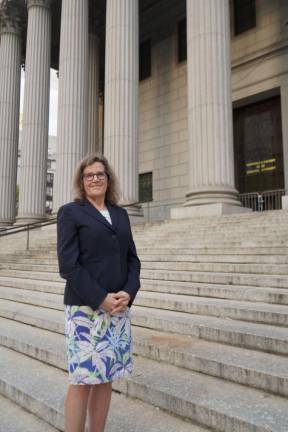Three NY County Supreme Court Judges Picked to Appear on November Ballot
Technically, the three judges picked by judicial delegates won’t be official until the November election is held, but since they will be running unopposed, the real race is over and the field of a half dozen is down to the three winners for full 14 year terms.

Judges can be seated - After months of meeting and greeting the judicial delegates who would decide their fate, three New York County Acting Supreme Justices have been nominated to be elected to fill three vacant seats on New York County Supreme Court in November. They are Judge Lyle Frank, Judge Phaedra Perry, and Judge Leslie Stroth.
They defeated three Acting Supreme Court Judges who were not nominated at the Judicial Convention this year that included: Judge Suzanne Adams, Judge Judy Kim, and Judge Gerald Liebovitz. If there is another vacancy or vacancies next year, the later three could be joined for consideration to an appointment along with about nine other judges including: Judges Jim Clynes, Christopher Chin, Ashlee Crawford, Hasa Kingo, Ilana Marcus, Eric Schumacher, Shahabuddeen (Shah) Ally, Kathleen Waterman Marshall, Aija Tingling..
It’s an unusual nominating process and not without some controversy. New York’s use of the delegate primary convention has been upheld as constitutional by the U.S. Supreme Court. However, the Brennan Center of New York University, among others, remain critical of the system. In pertinent part, here goes:
”In spite of the system’s democratic flaws, New York’s use of the delegate primary convention has survived constitutional scrutiny. The U.S. Supreme Court upheld its constitutionality in a 2008 decision (the plaintiff in the lawsuit, Judge Margarita López Torres, was represented by the Brennan Center), but emphasized that they backed neither the merit nor the wisdom of such a model. In a concurring opinion joined by Justice David Souter, Justice John Stevens said the ruling “should not be misread as endorsement of the electoral system under review.” Quoting Justice Thurgood Marshall, Justice Stevens added, ‘The Constitution does not prohibit legislatures from enacting stupid laws’.”
Judicial Delegates and Alternate Delegates are elected by Dem clubs in an Assembly District. Names appear on nominating petitions each year. Some districts have primaries. Delegates are generally members of Dem clubs in the Assembly District where they reside.
Supreme Court judges serve a 14 year term or until age 70 whichever comes first.
The number of delegates is determined by turnout of how many people voted on the Democratic line every four years in the gubernatorial election. Judicial candidates run on the Dem line. Usually the Republicans, Conservatives, Liberal and Working Family parties do not run an opposing candidate, but they can. A candidate who has the Dem line can, on their own, seek a cross-endorsement. In an uncontested race, they generally don’t seek a cross-endorsement. All clubs generally have judicial delegates. Sometimes there are warring factions and a primary results. Dem club members nominate judicial delegates and an equal number of alternate delegates. Only the judicial delegates vote at the Judicial Convention. If a judicial delegate does not appear at the convention or doesn’t vote at the convention, an alternate delegate will vote. Each club is allocated a certain number of delegates and if the number of delegates exceeds the number allocated to the club, the club votes on who their delegates will be.
The nominated delegates submit a statement telling why they want to be a delegate. Then, at a club meeting, each delegate candidate gives a short speech saying why they want to be a delegate.
Crossroads at 57th St crosstown - Used to be, in my youth and beyond, a time when 42nd St/Times Square was said to be the crossroads of the world. Now, meh, maybe. But as a lifelong New Yorker and a permanent resident of Manhattan (aka NY County) and East Side Observer (for Our Town), I’m thinking that ‘times they are a-changing.’ Take traffic for example. The old M104 bus, that runs down Broadway no longer turns left -uh, make that east- on 42nd Street. Instead it continues on 7th Avenue to its last stop at 41st and 7th. The old route included a stop at Grand Central Station and its last stop was 42nd St and the UN. The new route includes the Times Square Pedestrian Plaza as redesigned under Mayor Bloomberg.
Back to 57th Street and 7th Avenue, where the M104 still stops. In 1992 Sheldon/Shelly Fireman opened the Trattoria Dell’Arte restaurant on 7th Avenue directly opposite Carnegie Hall in the space then occupied by the Carnegie Tavern. At the time, Fireman owned Cafe Fiorello near Lincoln Center, which he opened in 1974 after having an ownership interest in the Tin Lizzie, a steakhouse, which closed.
As of today, at least three of Fireman restaurants occupy the 7th Avenue block between 56th and 57th Streets, as well as the Brooklyn Diner just east of 57th and 7th.
After cruel Covid, West 57th Street’s making a comeback. Think Billionaire’s Row between 6th and 7th Avenue on 57th. Nordstrom’s just off 8th on the northeast and northwest sides of the street. Petrossian, which was located in the Alwyn Court on 7th Avenue and 58th Street, is now located on West 13th St. Funny, at least to me, that a caviar emporium would leave with Billionaire’s Row just around the corner. Oh, well.
West 57th’s got more to tell. I’ll be back.